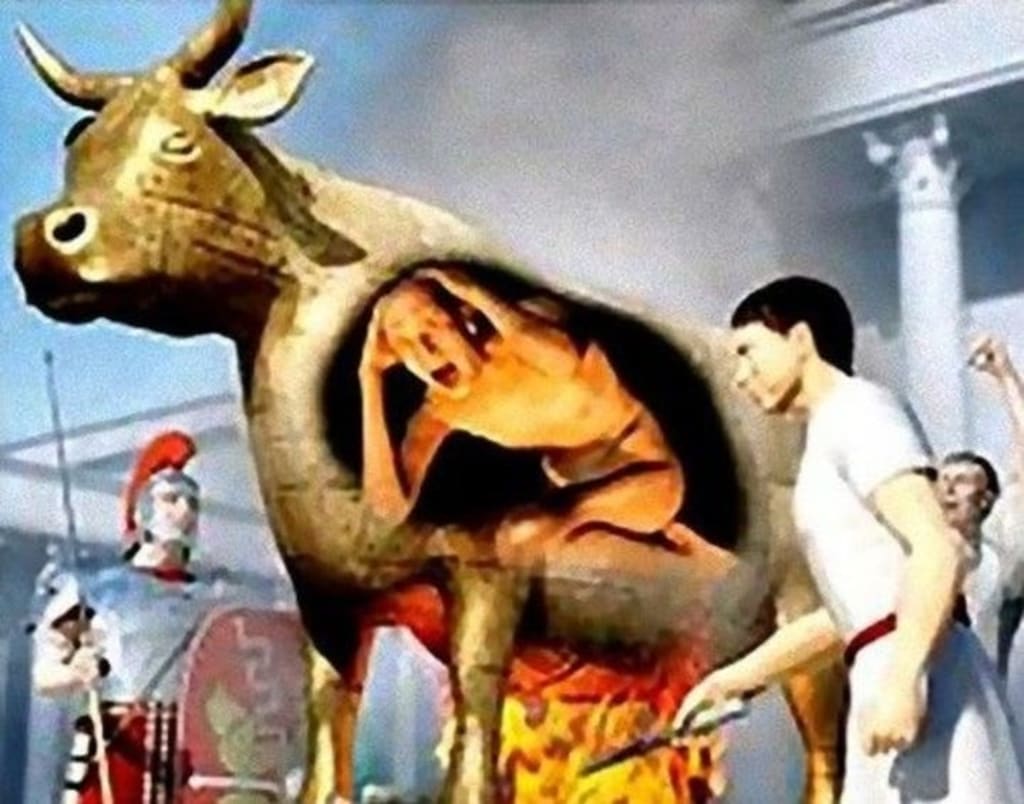
Antipas, Bishop of Pergamon during the persecutions of Emperor Domitian and the first martyr in Asia Minor, who was roasted to death in a brazen bull in AD 92. The device is claimed to have still been in use two centuries later, when another Christian, Pelagia of Tarsus, is said to have been burned in one in AD 287 by the Emperor Diocletian.
Francesco Ferdinandi, The Martyrdom of St. Eustace. Behind the main altar at the Church of Sant'Eustachio, Rome, this painting follows the narrative in the Golden Legend: For refusing to sacrifice to the gods, Saint Eustace and his wife and sons are to be executed in a brazen bull.
Diehl & Donnelly 2008, p. 37
Biblioteca Historica, IX, 18–19
Diehl & Donnelly 2008, p. 39
Pindar, Pythian 1
"Brazen Bull: The ancient Greek torture death machine". GHD. Retrieved 2021-12-25.
Thompson 2008, p. 30
"Phalaris | tyrant of Acragas | Britannica". www.britannica.com. Retrieved 2021-12-25.
Bibliography
Diehl, Daniel; Donnelly, Mark P. (2008), The Big Book of Pain: Punishment and Torture Through History, The History Press, ISBN 978-0-7509-4583-7
Thompson, Irene (2008), The A to Z of Punishment and Torture: From Amputations to Zero Tolerance, Book Guild Publishing, ISBN 978-1-84624-203-8
Designed by the ancient greeks, this method was also called the Sicilian bull, as it was invented in Sicily. This was a device made of bronze, in the shape and size of an actual bull. The condemned person would be locked inside and fire would be set beneath the bull, heating the bronze till the person inside got roasted to death. This device also had such systems that converted screams of the condemned into the bellows of a bull.
Purpose of the Brazen Bull
According to the historical record, the brazen bull device—a red-hot monster—was meant to torture and ultimately executed people. The theatrical nature of slowly roasting victims within the brazen bull's metallic stomach and their screams transformed into melodic bellows by flutes in the bull's nostrils undoubtedly struck fear into the populace and deterred them from acting out.
The sadic cruelty of this bull torture of Ancient Greece quickly became legendary, as well as the well-deserved demise of Phalaris and Perillos within it as victims of their own barbarism. It remained firmly rooted in the public's imaginations long after classical antiquity. For instance, the brazen bull captured the attention of writers and scholars such as the 14th-century Italian writer Dante Alighieri or the 19th-century Danish philosopher and theologian Soren Kierkegaard.
Why was the brazen bull made?
According to the ancient Greek historian Diodorus Siculus, the brazen bull was made by Perillos of Athens for the tyrant Phalaris to execute his enemies. The ruler was known for his cruelty, and the slow, painful death provided by the brazen bull seems to have appealed to his sadism.
How did the brazen bull work?
The hollow brazen bull had a door at its belly into which a victim or more could be placed and was made of metal. The device would heat up like an oven and effectively roast whoever was inside by lighting a fire underneath. Pipes leading from the belly up through the nostrils would carry the victim's screams, making it sound like the bull was lowing
What does the Brazen Bull do?
The brazen bull was an instrument of torture and execution. Roasting those placed within its hollow belly provided a slow and painful death. The people outside could hear this through the pipes in the nostrils.
What happened to the person who made the brazen bull?
Court sculptor Perillos of Athens is said to have invented the brazen bull for the tyrant Phalaris. To demonstrate its effectiveness, Phalaris had Perillos locked inside and roasted alive. Half-dead, his body was removed from the bull and thrown down the cliffs.
History is replete with brutally imaginative torture and execution techniques. The list of cruelties includes crucifixion, where victims were left to die on the cross; the rack, where torturers would place the victim on a wooden frame to be slowly pulled apart; and hanging, drawing, and quartering—the official English punishment for high treason from 1351 to 1870—where men would be drawn by horse to their place of execution, hung until near-death, and then emasculated and disemboweled before being decapitated and cut into quarters. The most intricately sadistic form of torture, however, originated with the Greek tyrant Phalaris.
Phalaris, the despot of Acragas (now Agrigento, in Sicily), was infamous for his callousness and reputedly “devoured” suckling infants. The video above describes how Phalaris, keeping to his character, asked the craftsman Perilaus to construct a bronze bull for the execution of criminals. The bull housed a hollow chamber where victims were deposited through a trapdoor. A fire was kindled beneath the bull, turning the statue into an oven.





Comments
There are no comments for this story
Be the first to respond and start the conversation.